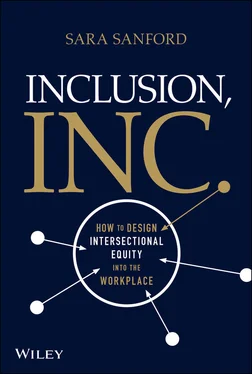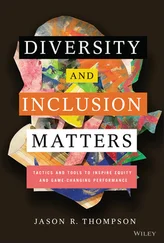Allies : Supporters of equity in principle often ask, “What can I do?” Anyone looking to improve their understanding of DEI concepts can use this book to become better allies and advocate for effective solutions.
Job Seekers: Job candidates want clear benchmarks to know if a potential employer has gone beyond talk to meaningful action. Anyone who wants to know if an employer is truly inclusive can use Inclusion, Inc as a “checklist” to assess whether an employer has gone beyond recruiting to authentic inclusion.
Beyond Good Intentions to Meaningful Impact
The methods in this book can take business culture to the next level.
Beyond Recruiting: While representation matters, companies need to do more than just recruit. If employees continue to be recruited into organizations that do not have the mechanisms in place to reduce the impact of bias, both the company and the employees lose out. For example, in the tech sector, the highest percentage of women who leave their employer exit at midcareer—the point at which it is most expensive for the company to replace them. 15 Inclusion, Inc addresses the pain points that cause underestimated employees to leave, saving employers the costs of attrition and turnover.
Beyond the Binary: Simply looking at gender as the difference between women and men does not give a complete picture of gender equity. In addition, simply looking at DEI in terms of race and gender ignores the intersections of many other facets of individual identity. Understanding these intersections is essential to ensuring that efforts to foster equity benefit everyone, not just the dominant group. Inclusion, Inc offers solutions that address inequities faced by communities of color, those who do not identify with the binary definitions of gender, caretakers, minimum wage workers, those who have a disability, those who may experience ageism, and workers of underrepresented nationalities and religions.
Beyond Compliance: Not being harassed or blatantly discriminated against is not a high bar for employee experience. Inclusion, Inc is driven by the knowledge that too many people aren't being given equal opportunities to demonstrate their talents. Underestimated individuals don't want to be tolerated—they want to be valued and appreciated on the same level as their peers.
DEI can be confusing for employers and employees alike. This book provides clarity so that employees can understand and recognize the facets of a truly inclusive workplace. It also provides businesses with an answer to “What can we do that works?” in the form of workplace design elements they can adopt immediately to become equity-centered, better serving employees, consumers, and society.
A Quick Guide to the Rest of This Book
This book has three goals, pursued in three parts.
The first, tackled in part 1, is to convince you that the trim-tab hypothesis is true. I want you to believe that shifting our perspective on DEI is important, that we need to leave old ways behind and focus on changing mechanics, not mindsets. This part will define who we're changing the workplace for, what will happen to them (and all of us) if we don't change course, and what it looks like to debias processes rather than people.
The second goal, addressed in part 2, is to show you how to implement the trim-tab approach by adjusting cultural levers throughout your organization. You'll learn how to attract more qualified candidates, hire the best person for the role, get the most out of meetings by actually hearing from everyone, and conduct a pay gap audit that's meaningful enough to turn into a pay equity strategy. I'll share why you should scrap the yearly review and what you should do instead. You'll learn why mentorship isn't enough, but sponsorship is, and how to make difficult decisions around transparency and target-setting.
This section will show how policies such as paid leave and flexibility may seem inclusive on the surface, but there is a right and a wrong way to implement them. From recruiting to professional development to office aesthetics and governance strategy, this part will reveal the trim tabs that unlock both social and financial returns.
The third goal is to get a handle on DEI tomorrow. Part 3reckons with the future but starts by looking at the past, specifically at lessons learned from the COVID-19 pandemic. This probably won't be the last society-wide crisis that employers face, and we can learn from businesses that managed to keep equity in focus, even in the midst of upheaval. Businesses that double down on equity in times of crisis come out of them stronger and continue to outperform the competition. An equitable emergency response plan is a more successful response plan.
Part 3will also provide tools and principles to navigate how AI and machine learning will impact the workplace. I believe we'll be seeing more and more businesses stating that their DEI strategies are “data-driven.” This doesn't mean that their DEI strategies are data-smart . Depending on how it is collected, analyzed, and interpreted, data can either drive transformative inclusion, or it can become a weapon of math destruction, 16 encoding human bias and scaling it across an organization. This section will give you a framework for asking the right questions in your engagement surveys and analyzing DEI data with an intersectional lens.
Finally, this part finishes with DEI principles to live by, including a focus on communication. Alongside the opportunity gaps in many organizations, I also see persistent communication gaps. Managers and executives who want to further their DEI strategies fear that they'll say the wrong thing. Human Resources leaders create effective policies, but employees never hear about them or don't understand the benefits because the message is not communicated clearly. This section covers common DEI communication mistakes and provides alternative scripts that you can rely on for difficult conversations.
≈
Before we move on to learning how to shift our DEI perspectives and embrace more equitable systems, we need to answer one critical question: What if we didn't?
1 1.“Being Black in Corporate America: An Intersectional Exploration” (Center for Talent Innovation, 2019), https://coqual.org/wp-content/uploads/2020/09/CoqualBeingBlackinCorporateAmerica090720-1.pdf; Neysa Dillon-Brown, “Women And Minorities Are Still Underrepresented in the Boardroom,” Corporate Board Member, February 20, 2019, https://boardmember.com/women-minorities-underrepresented-board/.
2 2.Lareina Yee, Alexis Krivkovich, Eric Kutcher, et al., “Women in the Workplace 2016” ( LeanIn.Organd McKinsey & Company, 2016), https://womenintheworkplace.com/2016.
3 3.Jessica Guynn, “Here's Why Women, Blacks and Hispanics Are Leaving Tech,” USA Today, July 9, 2020, https://www.usatoday.com/story/tech/news/2017/04/27/toxic-workplaces-technology-women-minorities-retention/100977038/.
4 4.“Generations of Progress for Women and Girls Could Be Lost to COVID Pandemic, UN Chief Warns,” UN News, United Nations, August 31, 2020, https://news.un.org/en/story/2020/08/1071372.
5 5.Brittany Chambers, “How The Coronavirus Has Resulted in the Highest Job Loss for Women: Erasing a Decade of Progress,” Forbes, May 12, 2020, https://www.forbes.com/sites/brittanychambers/2020/05/12/how-the-coronavirus-has-resulted-in-the-highest-job-loss-for-women-erasing-a-decade-of-progress/?sh=69fa558e192a.
6 6.Quentin Fottrell and Jeanette Settembre, “In the #MeToo Era, 60% of Male Managers Say They're Scared of Being Alone With Women at Work,” MarketWatch, June 16, 2019, https://www.marketwatch.com/story/men-are-afraid-to-mentor-female-colleagues-in-the-metoo-era-heres-what-not-to-do-2019-05-20.
Читать дальше












